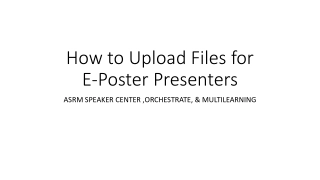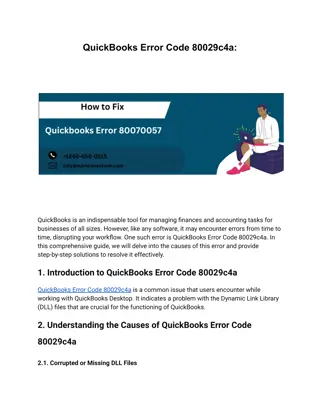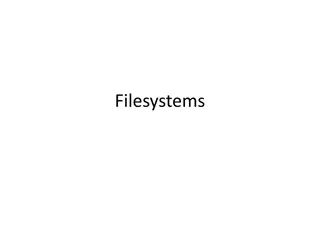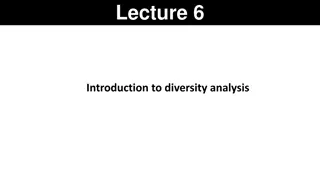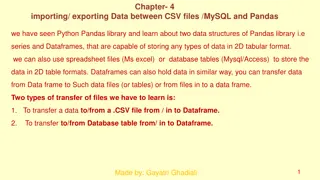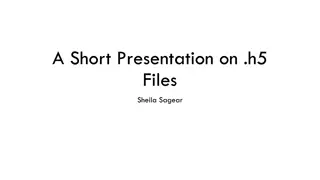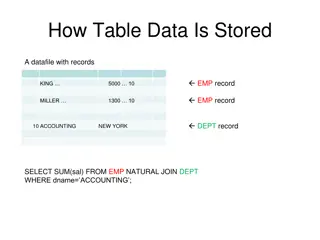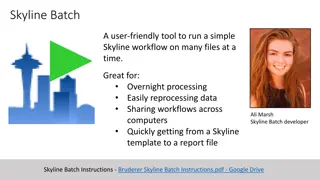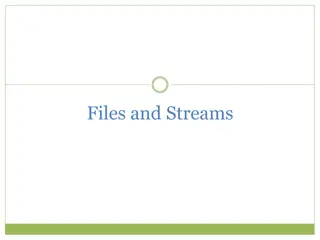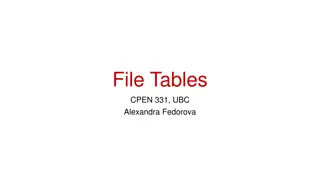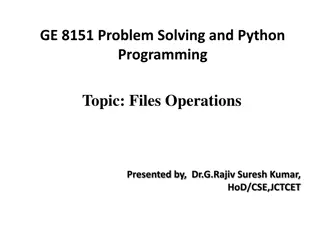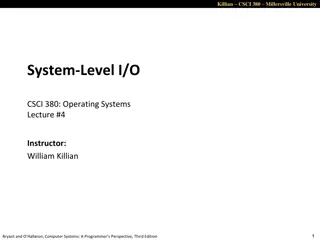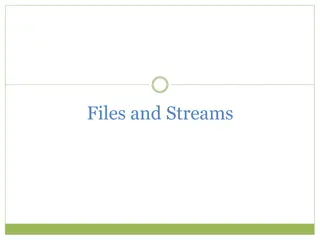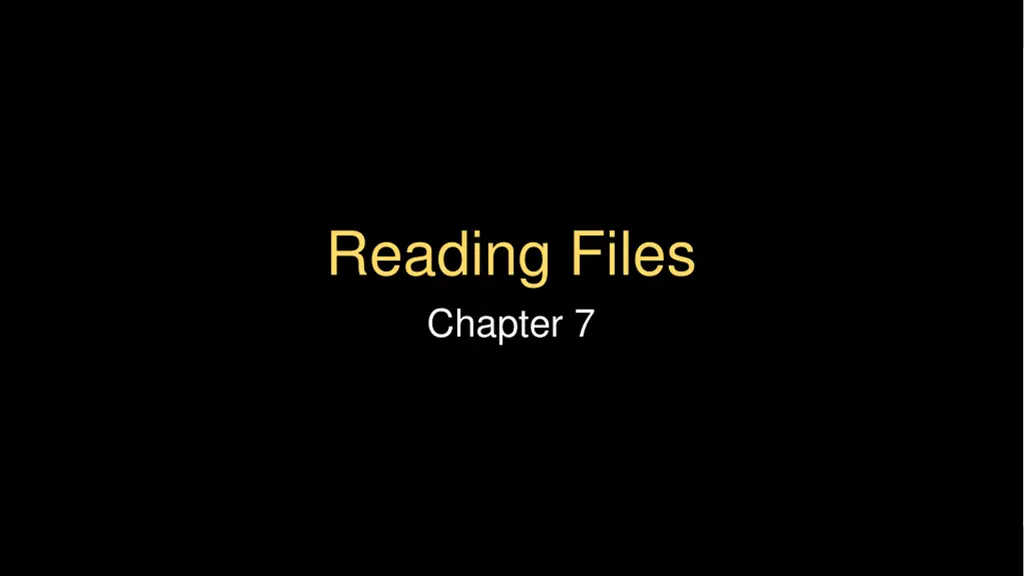
Dive into File Handling in Python with Essential Concepts
Explore the fundamental concepts of file handling in Python, from opening and handling files to understanding file handles and dealing with missing files. Learn how to work with text files efficiently and effectively in Python programming.
Download Presentation

Please find below an Image/Link to download the presentation.
The content on the website is provided AS IS for your information and personal use only. It may not be sold, licensed, or shared on other websites without obtaining consent from the author. If you encounter any issues during the download, it is possible that the publisher has removed the file from their server.
You are allowed to download the files provided on this website for personal or commercial use, subject to the condition that they are used lawfully. All files are the property of their respective owners.
The content on the website is provided AS IS for your information and personal use only. It may not be sold, licensed, or shared on other websites without obtaining consent from the author.
E N D
Presentation Transcript
Reading Files Chapter 7
It is time to go find some Data to mess with! Software What Next? Input Central Processing Unit and Output Devices Files R Us Secondary Memory if x < 3: print Main Memory From stephen.marquard@uct.ac.za Sat Jan 5 09:14:16 2008 Return-Path: <postmaster@collab.sakaiproject.org> Date: Sat, 5 Jan 2008 09:12:18 -0500To: source@collab.sakaiproject.orgFrom: stephen.marquard@uct.ac.zaSubject: [sakai] svn commit: r39772 - content/branches/Details: http://source.sakaiproject.org/viewsvn/?view=rev&rev=39772 ...
File Processing A text file can be thought of as a sequence of lines From stephen.marquard@uct.ac.za Sat Jan 5 09:14:16 2008 Return-Path: <postmaster@collab.sakaiproject.org> Date: Sat, 5 Jan 2008 09:12:18 -0500 To: source@collab.sakaiproject.org From: stephen.marquard@uct.ac.za Subject: [sakai] svn commit: r39772 - content/branches/ Details: http://source.sakaiproject.org/viewsvn/?view=rev&rev=39772 http://www.py4e.com/code/mbox-short.txt
Opening a File Before we can read the contents of the file, we must tell Python which file we are going to work with and what we will be doing with the file This is done with the open() function open() returns a file handle - a variable used to perform operations on the file Similar to File -> Open in a Word Processor
Using open() fhand = open('mbox.txt', 'r') handle = open(filename, mode) returns a handle use to manipulate the file filename is a string mode is optional and should be 'r' if we are planning to read the file and 'w' if we are going to write to the file
What is a Handle? >>> fhand = open('mbox.txt') >>> print(fhand) <_io.TextIOWrapper name='mbox.txt' mode='r' encoding='UTF-8'>
When Files are Missing >>> fhand = open('stuff.txt') Traceback (most recent call last): File "<stdin>", line 1, in <module> FileNotFoundError: [Errno 2] No such file or directory: 'stuff.txt'
The newline Character >>> stuff = 'Hello\nWorld!' >>> stuff 'Hello\nWorld!' >>> print(stuff) Hello World! >>> stuff = 'X\nY' >>> print(stuff) X Y >>> len(stuff) 3 We use a special character called the newline to indicate when a line ends We represent it as \n in strings Newline is still one character - not two
File Processing A text file can be thought of as a sequence of lines From stephen.marquard@uct.ac.za Sat Jan 5 09:14:16 2008 Return-Path: <postmaster@collab.sakaiproject.org> Date: Sat, 5 Jan 2008 09:12:18 -0500 To: source@collab.sakaiproject.org From: stephen.marquard@uct.ac.za Subject: [sakai] svn commit: r39772 - content/branches/ Details: http://source.sakaiproject.org/viewsvn/?view=rev&rev=39772
File Processing A text file has newlines at the end of each line From stephen.marquard@uct.ac.za Sat Jan 5 09:14:16 2008\n Return-Path: <postmaster@collab.sakaiproject.org>\n Date: Sat, 5 Jan 2008 09:12:18 -0500\n To: source@collab.sakaiproject.org\n From: stephen.marquard@uct.ac.za\n Subject: [sakai] svn commit: r39772 - content/branches/\n \n Details: http://source.sakaiproject.org/viewsvn/?view=rev&rev=39772\n
File Handle as a Sequence A file handle open for read can be treated as a sequence of strings where each line in the file is a string in the sequence xfile = open('mbox.txt') for cheese in xfile: print(cheese) We can use the for statement to iterate through a sequence Remember - a sequence is an ordered set
Counting Lines in a File fhand = open('mbox.txt') count = 0 for line in fhand: count = count + 1 print('Line Count:', count) Open a file read-only Use a for loop to read each line Count the lines and print out the number of lines $ python open.py Line Count: 132045
Reading the *Whole* File >>> fhand = open('mbox-short.txt') >>> inp = fhand.read() >>> print(len(inp)) 94626 >>> print(inp[:20]) From stephen.marquar We can read the whole file (newlines and all) into a single string
Searching Through a File fhand = open('mbox-short.txt') for line in fhand: if line.startswith('From:') : print(line) We can put an if statement in our for loop to only print lines that meet some criteria
OOPS! From: stephen.marquard@uct.ac.za What are all these blank lines doing here? From: louis@media.berkeley.edu From: zqian@umich.edu From: rjlowe@iupui.edu ...
OOPS! What are all these blank lines doing here? From: stephen.marquard@uct.ac.za\n \n From: louis@media.berkeley.edu\n \n From: zqian@umich.edu\n \n From: rjlowe@iupui.edu\n \n ... Each line from the file has a newline at the end The print statement adds a newline to each line
Searching Through a File (fixed) fhand = open('mbox-short.txt') for line in fhand: line = line.rstrip() if line.startswith('From:') : print(line) We can strip the whitespace from the right-hand side of the string using rstrip() from the string library From: stephen.marquard@uct.ac.za From: louis@media.berkeley.edu From: zqian@umich.edu From: rjlowe@iupui.edu .... The newline is considered white space and is stripped
Skipping with continue fhand = open('mbox-short.txt') for line in fhand: line = line.rstrip() if not line.startswith('From:') : continue print(line) We can conveniently skip a line by using the continue statement
Using in to Select Lines fhand = open('mbox-short.txt') for line in fhand: line = line.rstrip() if not '@uct.ac.za' in line : continue print(line) We can look for a string anywhere in a line as our selection criteria From stephen.marquard@uct.ac.za Sat Jan 5 09:14:16 2008 X-Authentication-Warning: set sender to stephen.marquard@uct.ac.za using f From: stephen.marquard@uct.ac.za Author: stephen.marquard@uct.ac.za From david.horwitz@uct.ac.za Fri Jan 4 07:02:32 2008 X-Authentication-Warning: set sender to david.horwitz@uct.ac.za using -f...
Prompt for File Name fname = input('Enter the file name: ') fhand = open(fname) count = 0 for line in fhand: if line.startswith('Subject:') : count = count + 1 print('There were', count, 'subject lines in', fname) Enter the file name: mbox.txt There were 1797 subject lines in mbox.txt Enter the file name: mbox-short.txt There were 27 subject lines in mbox-short.txt
fname = input('Enter the file name: ') try: fhand = open(fname) except: print('File cannot be opened:', fname) quit() Bad File Names count = 0 for line in fhand: if line.startswith('Subject:') : count = count + 1 print('There were', count, 'subject lines in', fname) Enter the file name: mbox.txt There were 1797 subject lines in mbox.txt Enter the file name: na na boo boo File cannot be opened: na na boo boo
Summary Secondary storage Searching for lines Opening a file - file handle Reading file names File structure - newline character Dealing with bad files Reading a file line by line with a for loop

